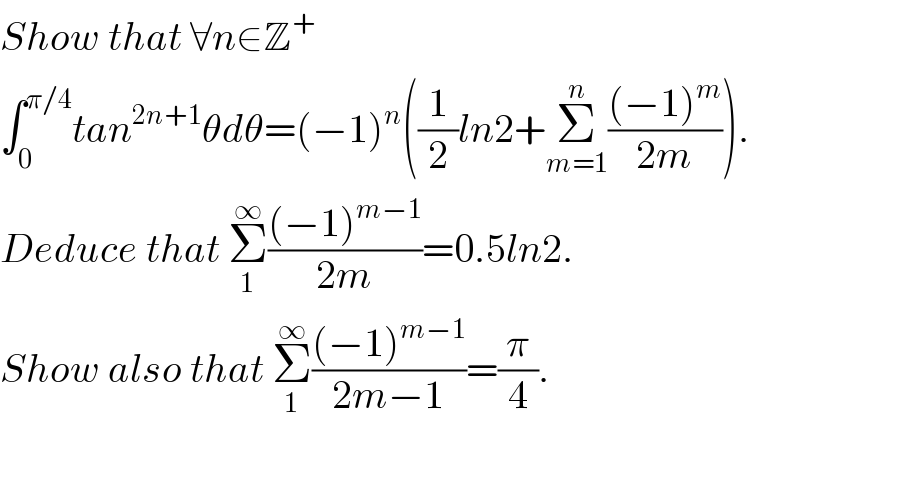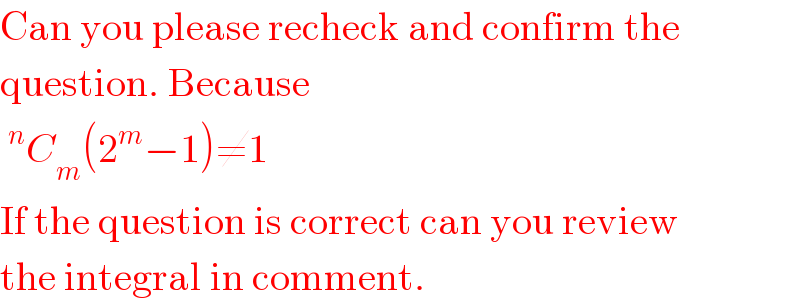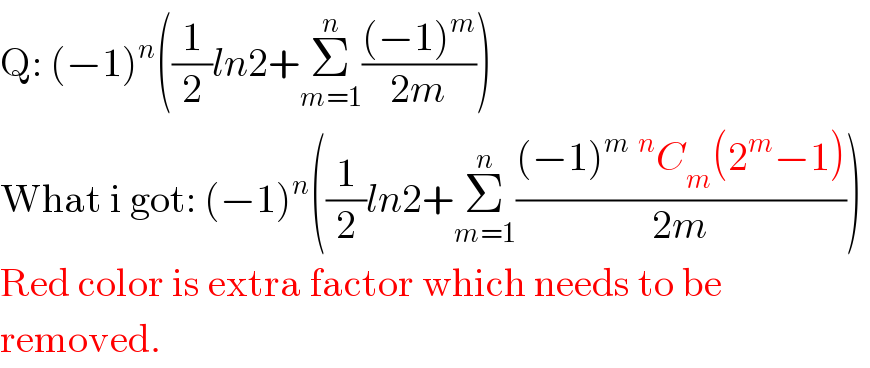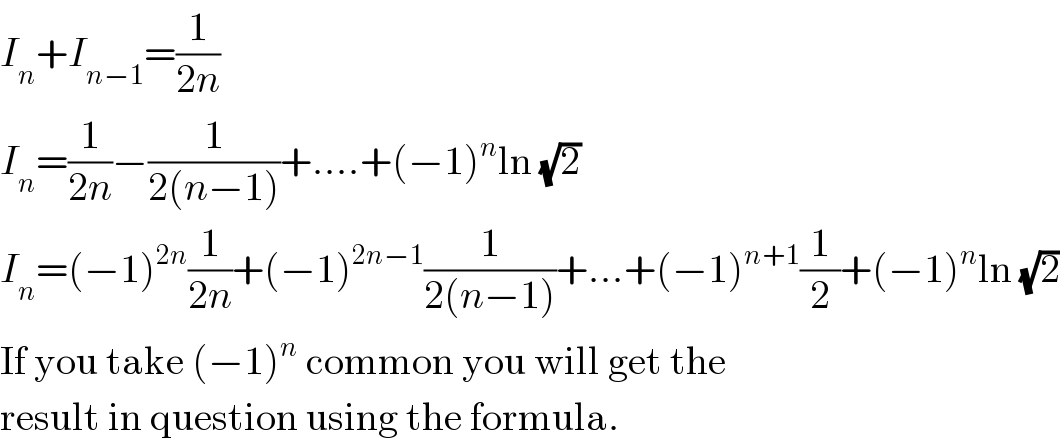
Question Number 2088 by Yozzi last updated on 01/Nov/15

$${Show}\:{that}\:\forall{n}\in\mathbb{Z}^{+} \\ $$$$\int_{\mathrm{0}} ^{\pi/\mathrm{4}} {tan}^{\mathrm{2}{n}+\mathrm{1}} \theta{d}\theta=\left(−\mathrm{1}\right)^{{n}} \left(\frac{\mathrm{1}}{\mathrm{2}}{ln}\mathrm{2}+\underset{{m}=\mathrm{1}} {\overset{{n}} {\sum}}\frac{\left(−\mathrm{1}\right)^{{m}} }{\mathrm{2}{m}}\right). \\ $$$${Deduce}\:{that}\:\underset{\mathrm{1}} {\overset{\infty} {\sum}}\frac{\left(−\mathrm{1}\right)^{{m}−\mathrm{1}} }{\mathrm{2}{m}}=\mathrm{0}.\mathrm{5}{ln}\mathrm{2}. \\ $$$${Show}\:{also}\:{that}\:\underset{\mathrm{1}} {\overset{\infty} {\sum}}\frac{\left(−\mathrm{1}\right)^{{m}−\mathrm{1}} }{\mathrm{2}{m}−\mathrm{1}}=\frac{\pi}{\mathrm{4}}.\: \\ $$$$ \\ $$
Commented by Yozzi last updated on 02/Nov/15
![It′s an old (1990) admission exam question and I wasn′t sure where the (−1)^n factor came from. Before the part I gave here the question asked about the sketches of the graph of y=tan^k θ for k=1 and k⋙1 where x∈[0,π/4]. Your method appears to be correct. I′m wondering what went wrong...](Q2108.png)
$${It}'{s}\:{an}\:{old}\:\left(\mathrm{1990}\right)\:{admission}\:{exam} \\ $$$${question}\:{and}\:{I}\:{wasn}'{t}\:{sure}\:{where} \\ $$$${the}\:\left(−\mathrm{1}\right)^{{n}} \:{factor}\:{came}\:{from}.\: \\ $$$${Before}\:{the}\:{part}\:{I}\:{gave}\:{here}\:{the} \\ $$$${question}\:{asked}\:{about}\:{the}\:{sketches} \\ $$$${of}\:{the}\:{graph}\:{of}\:{y}={tan}^{{k}} \theta\:{for}\: \\ $$$${k}=\mathrm{1}\:{and}\:{k}\ggg\mathrm{1}\:{where}\:{x}\in\left[\mathrm{0},\pi/\mathrm{4}\right]. \\ $$$${Your}\:{method}\:{appears}\:{to}\:{be}\:{correct}. \\ $$$${I}'{m}\:{wondering}\:{what}\:{went}\:{wrong}... \\ $$$$ \\ $$
Commented by prakash jain last updated on 03/Nov/15
![tan^(2n+1) θ=(tan^2 θ)^n tan θ =(sec^2 θ−1)^( n) tan θ =(−1)^n (1−sec^2 θ)^n tan θ =(−1)^n [tan θ+Σ_(m=1) ^n ^n C_m (−1)^m sec^(2m) θtan θ] =(−1)^n [tan θ+Σ_(m=1) ^n (−1)^m sec^(2m−1) θ∙sec θ∙tan θ] Integrating =(−1)^n [ln sec θ+Σ_(m=1) ^n (−1)^m ∙^n C_m ((sec^(2m) θ)/(2m))] limits 0 to (π/4) =(−1)^n [ln (√2)+Σ_(m=1) ^n (−1)^m ∙^n C_m ∙ ((2^m −1)/(2m))] more simplifications to be done.](Q2104.png)
$$\mathrm{tan}^{\mathrm{2}{n}+\mathrm{1}} \theta=\left(\mathrm{tan}^{\mathrm{2}} \theta\right)^{{n}} \mathrm{tan}\:\theta \\ $$$$=\left(\mathrm{sec}^{\mathrm{2}} \theta−\mathrm{1}\right)^{\:{n}} \mathrm{tan}\:\theta \\ $$$$=\left(−\mathrm{1}\right)^{{n}} \left(\mathrm{1}−\mathrm{sec}^{\mathrm{2}} \theta\right)^{{n}} \mathrm{tan}\:\theta \\ $$$$=\left(−\mathrm{1}\right)^{{n}} \left[\mathrm{tan}\:\theta+\underset{{m}=\mathrm{1}} {\overset{{n}} {\sum}}\:^{{n}} {C}_{{m}} \left(−\mathrm{1}\right)^{{m}} \mathrm{sec}^{\mathrm{2}{m}} \theta\mathrm{tan}\:\theta\right] \\ $$$$=\left(−\mathrm{1}\right)^{{n}} \left[\mathrm{tan}\:\theta+\underset{{m}=\mathrm{1}} {\overset{{n}} {\sum}}\left(−\mathrm{1}\right)^{{m}} \mathrm{sec}^{\mathrm{2}{m}−\mathrm{1}} \theta\centerdot\mathrm{sec}\:\theta\centerdot\mathrm{tan}\:\theta\right] \\ $$$$\mathrm{Integrating} \\ $$$$=\left(−\mathrm{1}\right)^{{n}} \left[\mathrm{ln}\:\mathrm{sec}\:\theta+\underset{{m}=\mathrm{1}} {\overset{{n}} {\sum}}\left(−\mathrm{1}\right)^{{m}} \centerdot\:^{{n}} {C}_{{m}} \frac{\mathrm{sec}^{\mathrm{2}{m}} \:\theta}{\mathrm{2}{m}}\right] \\ $$$${limits}\:\mathrm{0}\:{to}\:\frac{\pi}{\mathrm{4}} \\ $$$$=\left(−\mathrm{1}\right)^{{n}} \left[\mathrm{ln}\:\sqrt{\mathrm{2}}+\underset{{m}=\mathrm{1}} {\overset{{n}} {\sum}}\:\left(−\mathrm{1}\right)^{{m}} \centerdot\:^{{n}} {C}_{{m}} \centerdot\:\frac{\mathrm{2}^{{m}} −\mathrm{1}}{\mathrm{2}{m}}\right] \\ $$$$\mathrm{more}\:\mathrm{simplifications}\:\mathrm{to}\:\mathrm{be}\:\mathrm{done}. \\ $$
Commented by prakash jain last updated on 02/Nov/15

$$\mathrm{Can}\:\mathrm{you}\:\mathrm{please}\:\mathrm{recheck}\:\mathrm{and}\:\mathrm{confirm}\:\mathrm{the} \\ $$$$\mathrm{question}.\:\mathrm{Because}\: \\ $$$$\:^{{n}} {C}_{{m}} \left(\mathrm{2}^{{m}} −\mathrm{1}\right)\neq\mathrm{1}\: \\ $$$$\mathrm{If}\:\mathrm{the}\:\mathrm{question}\:\mathrm{is}\:\mathrm{correct}\:\mathrm{can}\:\mathrm{you}\:\mathrm{review} \\ $$$$\mathrm{the}\:\mathrm{integral}\:\mathrm{in}\:\mathrm{comment}. \\ $$
Commented by prakash jain last updated on 03/Nov/15

$$\mathrm{Q}:\:\left(−\mathrm{1}\right)^{{n}} \left(\frac{\mathrm{1}}{\mathrm{2}}{ln}\mathrm{2}+\underset{{m}=\mathrm{1}} {\overset{{n}} {\sum}}\frac{\left(−\mathrm{1}\right)^{{m}} }{\mathrm{2}{m}}\right)\: \\ $$$$\mathrm{What}\:\mathrm{i}\:\mathrm{got}:\:\left(−\mathrm{1}\right)^{{n}} \left(\frac{\mathrm{1}}{\mathrm{2}}{ln}\mathrm{2}+\underset{{m}=\mathrm{1}} {\overset{{n}} {\sum}}\frac{\left(−\mathrm{1}\right)^{{m}} \:^{{n}} {C}_{{m}} \left(\mathrm{2}^{{m}} −\mathrm{1}\right)}{\mathrm{2}{m}}\right)\: \\ $$$$\mathrm{Red}\:\mathrm{color}\:\mathrm{is}\:\mathrm{extra}\:\mathrm{factor}\:\mathrm{which}\:\mathrm{needs}\:\mathrm{to}\:\mathrm{be} \\ $$$$\mathrm{removed}. \\ $$
Commented by Yozzi last updated on 03/Nov/15

$${I}\:{derived}\:{a}\:{reduction}\:{formula}\:{which} \\ $$$${excludes}\:{the}\:{factor}\:\begin{pmatrix}{{n}}\\{{m}}\end{pmatrix}\:\left(\mathrm{2}^{{m}} −\mathrm{1}\right) \\ $$$${when}\:{used}\:{to}\:{prove}\:{the}\:{answer}. \\ $$$${But},\:{I}\:{don}'{t}\:{know}\:{how}\:{the}\:{factor}\:\left(−\mathrm{1}\right)^{{n}} \\ $$$${comes}\:{in}. \\ $$$$\:\:\:\:\:\:\:\:\:\:\:\:\:\:\:\:\:\:\:\:\:\:{I}_{{n}} +{I}_{{n}−\mathrm{1}} =\frac{\mathrm{1}}{\mathrm{2}{n}} \\ $$$${n}\geqslant\mathrm{2},{I}_{{n}} =\int_{\mathrm{0}} ^{\pi/\mathrm{4}} {tan}^{\mathrm{2}{n}+\mathrm{1}} \theta{d}\theta. \\ $$
Commented by prakash jain last updated on 03/Nov/15

$${I}_{{n}} +{I}_{{n}−\mathrm{1}} =\frac{\mathrm{1}}{\mathrm{2}{n}} \\ $$$${I}_{{n}} =\frac{\mathrm{1}}{\mathrm{2}{n}}−\frac{\mathrm{1}}{\mathrm{2}\left({n}−\mathrm{1}\right)}+....+\left(−\mathrm{1}\right)^{{n}} \mathrm{ln}\:\sqrt{\mathrm{2}} \\ $$$${I}_{{n}} =\left(−\mathrm{1}\right)^{\mathrm{2}{n}} \frac{\mathrm{1}}{\mathrm{2}{n}}+\left(−\mathrm{1}\right)^{\mathrm{2}{n}−\mathrm{1}} \frac{\mathrm{1}}{\mathrm{2}\left({n}−\mathrm{1}\right)}+...+\left(−\mathrm{1}\right)^{{n}+\mathrm{1}} \frac{\mathrm{1}}{\mathrm{2}}+\left(−\mathrm{1}\right)^{{n}} \mathrm{ln}\:\sqrt{\mathrm{2}} \\ $$$$\mathrm{If}\:\mathrm{you}\:\mathrm{take}\:\left(−\mathrm{1}\right)^{{n}} \:\mathrm{common}\:\mathrm{you}\:\mathrm{will}\:\mathrm{get}\:\mathrm{the} \\ $$$$\mathrm{result}\:\mathrm{in}\:\mathrm{question}\:\mathrm{using}\:\mathrm{the}\:\mathrm{formula}. \\ $$
Commented by Yozzi last updated on 03/Nov/15

$${I}\:{see}.\:{Thanks}! \\ $$
